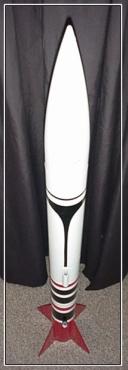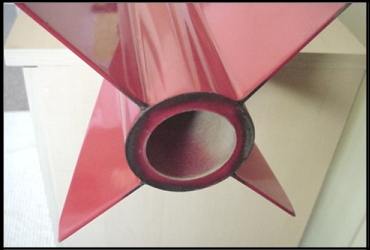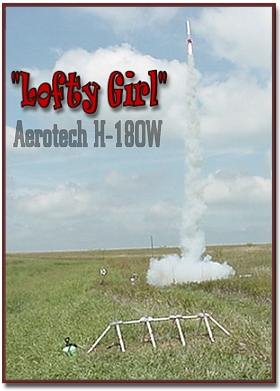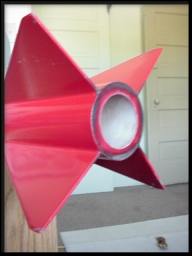| Manufacturer: | LOC/Precision  |

 Brief:
Brief:
Being a fresh BAR (born again rocketeer), I was looking for a good solid bird that I could attempt my Level 1 Certification with. After a couple of days of poking around on the web, I decided to go with the Caliber ISP, manufactured by LOC Precision. At a strong 56" in length and 3.1" dia. airframe, she seemed like the perfect mid-sized rocket for the Tripoli(r) Level 1 certification.
The kit boasts a single stage, 54mm motor mount around the reliable LOC airframe and 4 almost completely triangle-shaped fins that sweep a bit forward along the aft edge of 10 inches across. The finished vehicle weighs in at just over 2.5 pounds, making it a great kit for anyone looking to acquire their level 1 cert. or a great all-around sport flyer!
It is designed to utilize the "Old Reliable" wadding, shock cord, ejection charge and LOC's 35" nylon 'chute to complete the recovery system.
With classic styling and quite a history behind this popular LOC Kit, I have decided to stick with traditional methods of recovery to keep with the original style that LOC intended. I will, for the time being, utilize no altimeter, electronics or modern-day Nomex/Kevlar add-me-ons. This bird will operate by the rules of the "Old School". I figure it this way; what a better way to be rewarded with a level 1 cert. than keeping with the simple, proven methods of years gone by!
The kit was shipped quickly and arrived on the very day it was expected. This should prove to be a real joy to build and it makes my first rocket, an Estes V-2 from at least twenty years ago, look like a bubble-gum toy! I am already traumatizing myself over which color the finished bird will assume. Being a former Auto-Body/Paint Specialist, I take the cosmetics much more seriously than I would have to, but the extra time spent on finishing is always rewarding. Well, lets take her out of the box and see what she's made of, shall we?
Construction:
The Caliber was shipped with no damage at all, and contained in the heavy plastic bag with the label and seal in tact. The body tubes were perfectly round, measuring 14" and 34". The fins are wooden, five ply laminate as are the (2) centering rings and bulkhead. A 11 1/4" long plastic nose cone comes with the kit. I was surprised at how well the seam along both sides of the cone looked. Just a bit of scraping with the hobby knife should knock the ridge down to a finishable level in no time! The nose cone was just a touch too loose for my taste, but I guess that is way better than being too tight! A wrap or two of trusty masking tape will be all the security it needs. LOC has included a six inch tube coupler, complete with a ply bulkhead and solid mounting hardware for the recovery system. I did not exactly measure the length of the 3/4 inch elastic shock cord, but there is a bunch of it! This will prove to be priceless later at the launch site. (story at ten)
 The fins come with square cut edges so I beveled them out about 3/4 of an inch on both sides of all the leading and parallel edges however, I did not bevel the aft edges of the fins. I became a bit concerned when I noticed that all four fins had a minuscule warp which bowed the fins all the same direction. This warped shape was very slight though, and I think the fin alignment during construction is the real important thing. The maiden voyage of this bird will be my certification flight so time will soon tell the story on the fins!
The fins come with square cut edges so I beveled them out about 3/4 of an inch on both sides of all the leading and parallel edges however, I did not bevel the aft edges of the fins. I became a bit concerned when I noticed that all four fins had a minuscule warp which bowed the fins all the same direction. This warped shape was very slight though, and I think the fin alignment during construction is the real important thing. The maiden voyage of this bird will be my certification flight so time will soon tell the story on the fins!
The assembly instructions for the kit are printed on the illustration and technical info card, which is a very familiar sight and style. All in all there are 20 parts to the kit, not too much to shuffle through here. The booster section is pre-slotted which really put the 'E' in easy for this rocket. Anyone having some previous experience with general rocket construction should have no problem at all with the Caliber ISP. I will be making the first flights on a 29mm H motor, but the 54mm mount that the ship is built around would definitely put this thing out of sight on what I am sure would be spectacular flights! With this interestingly on my mind, I took some extra measures to ensure the construction will hold up to the more powerful flights.
I gave the fin slots, openings and raw edges all a good dose of CA glue before I did anything else. I am one to dive right into a project like this, so I put a baggie over my hand and gave the inside of the lower airframe some wet kisses with the CA as well. I was sure to not use too much as to totally saturate the poor thing, but a light coating inside the standard LOC airframe gives the construction adhesive something to really bite down on.
I used a 30 min. epoxy for all the general and high stress assemblies. I left the rear CR unbonded with just the fore CR grabbing hold of a good bunch of epoxy to give it a strong adhesion with plenty of extra to produce a ready made 'fillet' at the adhesion point inside the airframe. I had heard that it is a good idea to slightly twist and pull the MMT/CR'S a short distance in and out of the tube to assure a good bond. I allowed the epoxy to do its thing and when it was set, I pushed the rear CR out using a bent coat hangar through the fin slots.
I generously coated the inside fillets and did three applications of epoxy on all the fin/motor/body tube joints. The 3.1 inch diameter body tube does not give you much leeway to apply the epoxy in there so I made a funnel out of waxed paper and poured epoxy through it to coat all the joints inside the tube, doing two joints at a time. Of course, make sure you readily clean up any drips or smears of epoxy from the precious fin slots and motor tube. I use Bounty paper towels which soak up even the thickest mixtures. If you miss any epoxy drips or sags, they will surely be a son-of-a-gun to smooth out when cured! At this point, I will refrain from mentioning the manufacturer's name that made the epoxy adhesive I used for the fin fillets during the construction, but if you get nothing else out of this review, please head this warning: Use ONLY good quality adhesives made by a name you can trust! The particular so-called 'wonder epoxy' that I used for the fillets did not chemically react the way it should have. It stayed very sticky and soft and would not set up. Thankfully I had used the other epoxy to adhere the motor mount into the airframe and the trouble started with the bargain glue here, on the fin fillets. Now I like my fillets to look very smooth and even, which stems from my days as an auto painter. It ended up I had to take a rounded butter knife and dig the soft, un-cured epoxy out of the fin/body fillet points. I cursed the manufacturer of the product at least a dozen times while just basically making a mess of everything. Now, what was supposed to be a beautiful fillet job ended up looking like the surface of the moon!
Fortunately, it seems that every misfortune that occurs in this rewarding hobby usually comes with a free lesson attached somewhere. This is the lesson from my crater-like fillet goo-goo job.... "A pretty good coat of CA can cure lots of things." I coated the heck out of the damaged fin fillets and surprisingly enough, what was left of the gooey mess suddenly turned solid and workable once more! I wanted to pass this info along so keep this trick in mind if you ever have the same problem. It worked for me and I just went on and finished the fillets out like normal. The bird is looking good and the fillet nightmare is over!
Finishing:
As far as finishing my Caliber, I just hit the body tubes and nose cone with some 220 grit paper. I washed the nose cone with soap and warm water first. This cleans the remaining release agent from the plastic before you drive it into the bonding points for your primer. I used easy-sanding automotive primer in a grit-decreasing, 3 cycle succession of sanding and re-priming. I always use a primer that sands easily when dry. Many primers claim to be sandable, but they do a better job of clogging your paper up. Be sure your primer is dry-sandable. After the first sanding, I hit the remaining problem cosmetics with some red 3M spot putty. This stuff is a real God-send! It sands very easily, quickly producing a level surface to apply your No. 2 and 3 coats of primer. I final sanded with a tri-fold of 600 grit. After cleaning the surface with a tack cloth, I gave the bird three coats of white Krylon(r) and just did a simple design of a red tail section and ! a couple of black stripes around the tube here and there. She looks great and I can sleep well knowing that my fin fillets are once again rock solid! I rate the overall Construction/Finishing a 4.5 instead of a 5 due to the slightly warped fins. Everything else is very good about this kit!
Construction Rating: 4 out of 5
 Flight:
Flight:
There is a certification story written by me about this very rocket and its first flights in EMRR's Certification stories section. A detailed account of the day is there so I will not go into too much detail about the flights here. You are invited to look over the certification story at any time. I wish to thank EMRR for publishing my story and I look forward to writing more.
The first flight was to count for my Level 1 so I was anxious to take to the skies! Using an AT H128-W and medium delay, the Caliber leaped to life! A beautiful lift-off with lots of great noise and thick column of smoke! She flew straight as a bullet so my concern for the warped fins was unwarranted after all! The parachute deployed at optimum time and the certification was complete! I launched her again after the damage-free recovery from the first voyage on an AT H180-W. A lot faster off the pad, still straight as she could be, but a quick delay caused a zipper in the tube. The day was done, and with certification in hand, I am anxiously building up for my level 2.
 Recovery:
Recovery:
The general, run of the mill, wadding, cord and 35" chute recovery system of the Caliber worked just fine for me. I think I will change to a different material for the shock cord mount/harness assembly now that I have to cut 81/4 inches of length off my now called "Lofty Girl" Caliber ISP. I think I will use a Rocketman 'chute when I get her fixed up. Not that the standard LOC 'chute is no good, it got me my Certification with no problem. I just dig the looks of those Rocketman ones!
Flight Rating: 5 out of 5
Summary:
I feel that this kit is a great qualifier for the next level from Mid to High power. I found it to be very easily assembled in addition to tutoring the basics of structural design that will be needed for more powerful level 2 and 3 flights of much larger vehicles. If you can see from the photos, after just three flights, the aft end of my 'Lofty Girl' is becoming blackened and scorched. I think it gives the girl some character, but if you would want to avoid this happening to your Caliber ISP, I think installing an Aeropack motor retainer would move the flame back below the airframe another half an inch and drastically reduce the heat to bird ratio.
Overall Rating: 4 out of 5
 |
 |
Flights
 |
 |
Sponsored Ads
 |
 |












J. .E. (May 24, 2009)